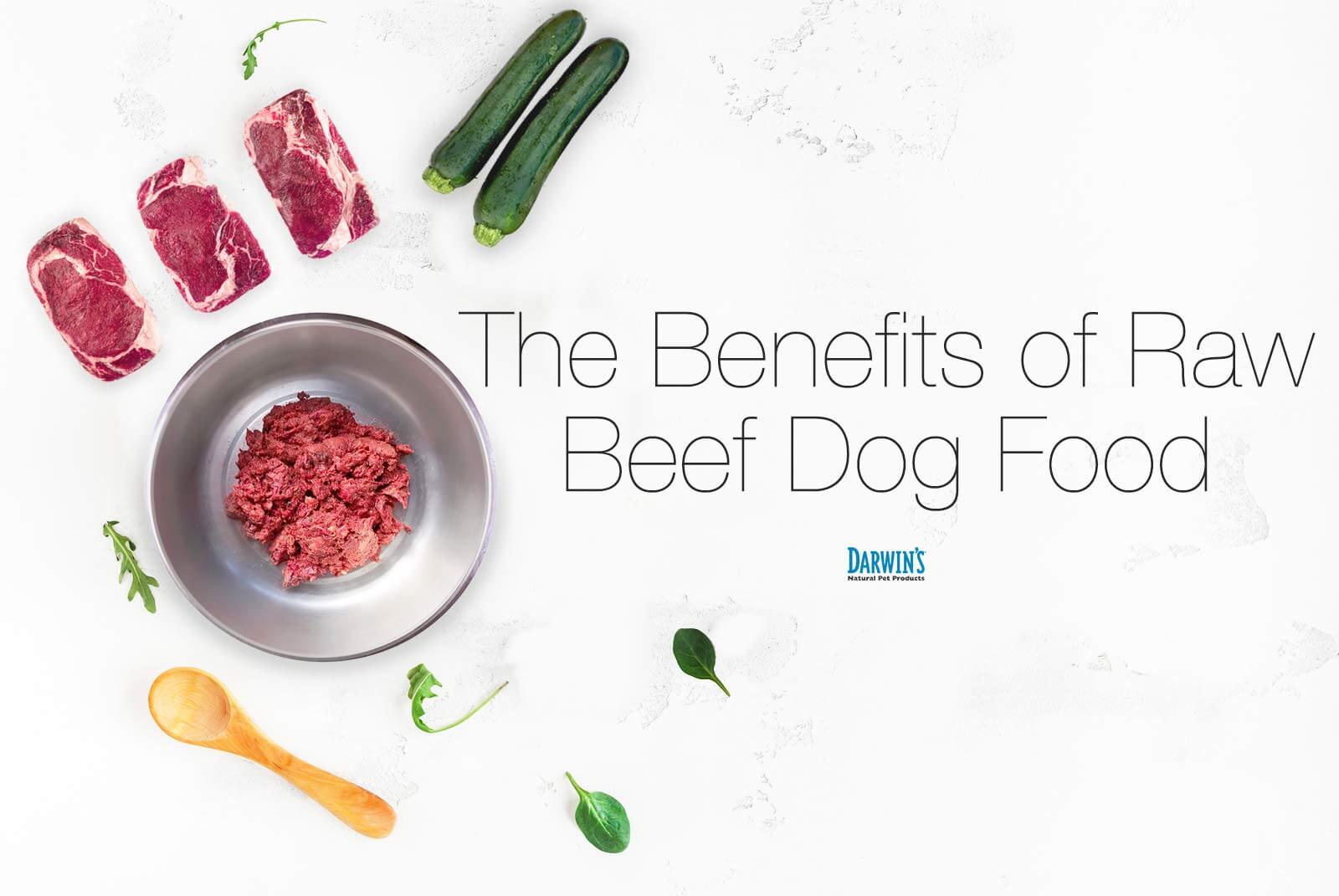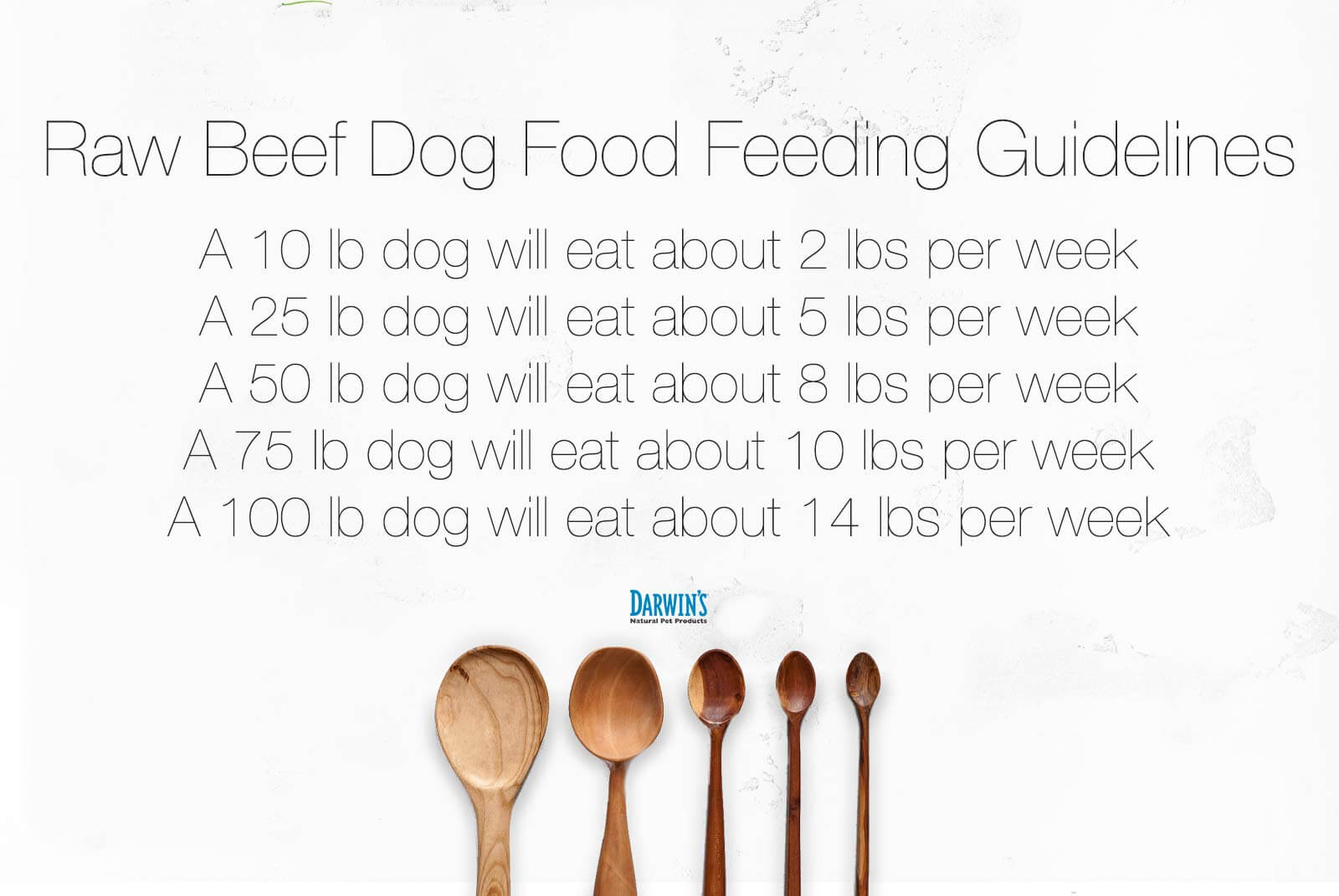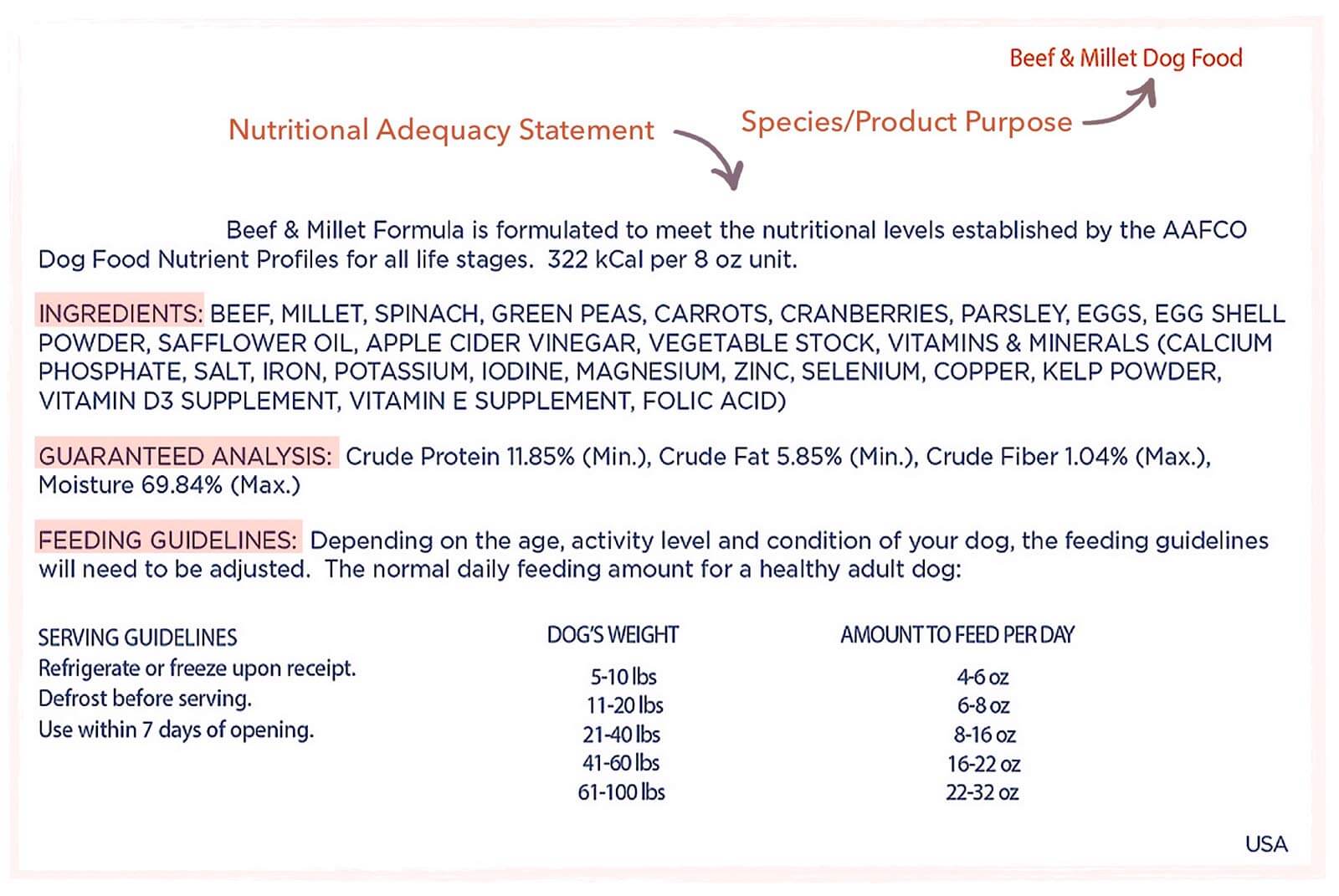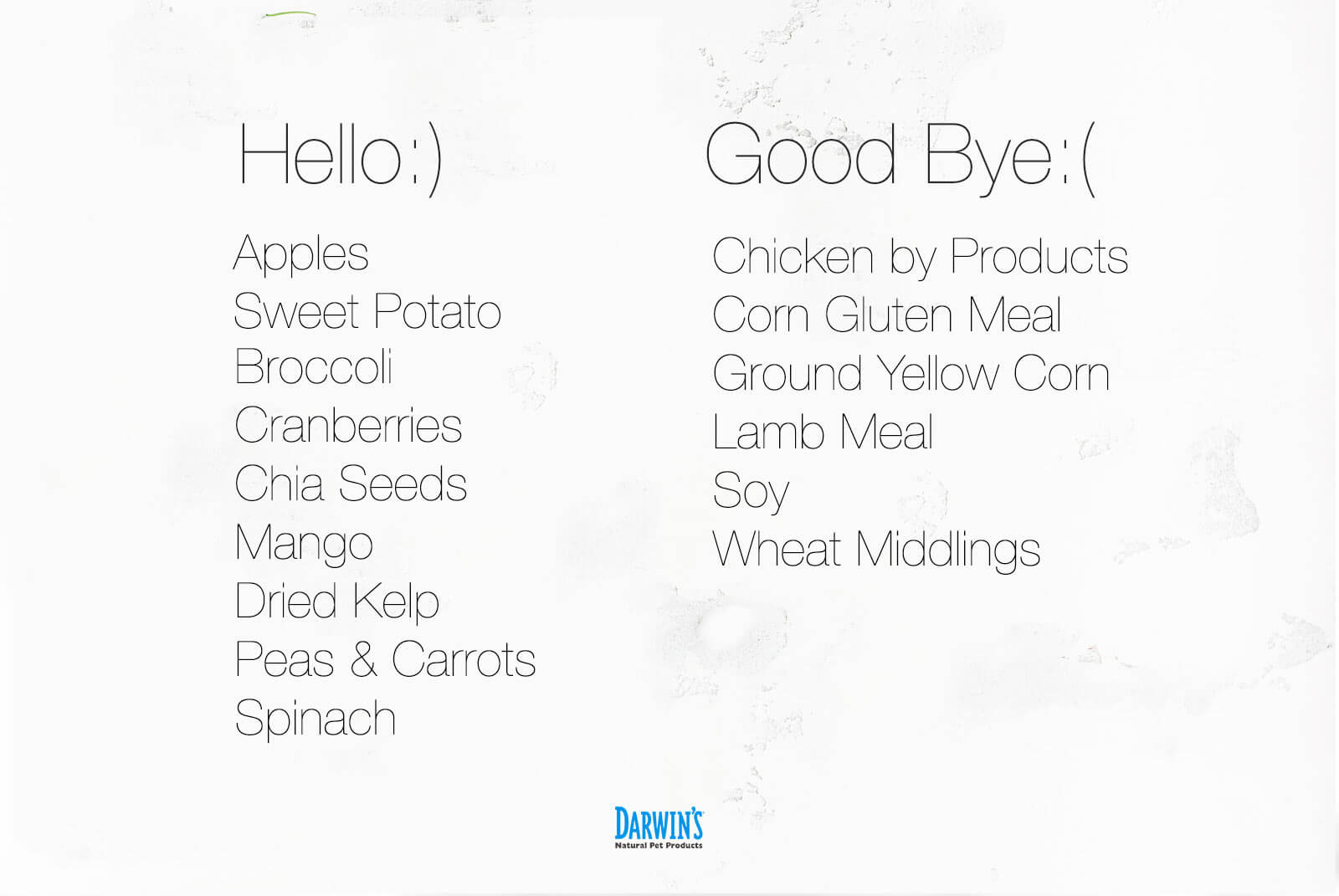Nutritionally Balanced Raw Beef Dog Food
7/31/18

Last Updated on
There’s ‘Beef Dog Food,’ and Then There’s the Real Thing: Raw Beef Dog Food
Once you take a careful look at many commercial dog food labels, you might ask yourself, “Where’s the beef?” Many ‘beef dog foods’ have a low percentage of real beef and those are often from questionable sources. That’s why feeding your pet raw beef dog food can make all the difference in the overall health of your dog.
In this article, you’ll learn what to look for in beef dog food and gain an understanding of the ins and outs of labeling. You’ll also find a glossary to clear up confusing terms, the benefits of raw beef dog food, and why choosing a tailored dog food is right for your dog – and for you as a concerned caretaker.
What’s Beef Dog Food and Why Is It Great Nutrition for Your Pet?
Protein is the single most vital component in your canine companion’s diet. That’s why beef is an excellent choice. Beef is a high-protein nutrient source that is rich in B vitamins and iron, which are essential for the long-term health and vitality of growing puppies, adult, and senior dogs.

To help dog owners understand the power of beef protein and how it supports your pet’s health, we talked to Dr. Judy Morgan, an expert on natural pet health certified in acupuncture, food therapy, and chiropractic care for dogs, cats, and horses. Morgan is also the author of multiple books on holistic pet healing, her latest is Ying & Yang Nutrition for Dogs: Maximizing Health with Whole Foods, Not Drugs When asked about beef as a preferred food for dogs, Morgan explains, “Beef contains high-quality amino acids that are necessary for good health in dogs. L-carnitine and taurine are two amino acids that contribute to cardiac health but are often lacking in many pet foods.”
Protein, Amino Acids, and Pet Nutrition
Proteins are made up of amino acids, the organic substances that are the building blocks of proteins and also the end product of the decomposition of specific proteins. Twenty-two amino acids are required by dogs to create the proteins they need. Your dog’s body is able to produce about half of these essential amino acids, but the rest must come from daily nutrition. Without them, amino acid deficiencies can create health issues.
Benefits of Raw Beef Dog Food
“I’m a huge proponent of raw feeding,” explains Morgan. “Fats undergo peroxidation when cooked, which can lead to inflammatory reactions in the body and an increased risk of pancreatitis.” Peroxidation damages cell membranes and the end product of the process may be carcinogenic and/or mutagenic.
The concept of a raw beef or other raw food diet is that it conforms to a canine’s carnivorous roots and that uncooked, unprocessed meat is nutritionally superior to other feeding options. Commercial raw food diets are formulated to be complete and balanced. To retain freshness (and avoid preservatives) they are usually frozen. The benefit of feeding raw beef or any other meat is that you know exactly what you are giving your dog to eat. Here are some of the benefits:
- Increased Energy: Better nutrition naturally boosts strength and vigor in a dog.
- Healthier Skin and Coat: Skin problems are a common malady for dogs and are often caused by food sensitivity. A more natural, low-grain diet can bring relief.
- Controlled Weight: High-water content in raw beef dog food means that your dog may be able to eat more while keeping calories low.
- Improved Health Conditions: Owners and vets have reported that it can improve common conditions and diseases such as arthritis and diabetes.
- Less “Stink”: Fresher breath, improved digestion, and smaller quantities of almost odorless poop.
- Increased Longevity: Improved quality and longer life for your companion.
To learn more about the benefits of feeding raw beef and other meats, take a look at Why Raw.
Raw Beef Dog Food Feeding Guidelines
To feed your dog appropriately, first consider her size—big dogs generally need more protein. Adult and senior dogs usually need lower calorie, fat, and protein intake. An adult dog should typically consume about two to four percent of its ideal body weight every day. You can also consider the size of your dog: bigger dogs generally need to consume a lower percentage of their body weight, and smaller dogs should eat a higher percentage of their body weight because the weight of the intestines in large dogs is only three percent of their body weight compared to seven percent in smaller breeds. There is less intestinal area for digestion and absorption of the nutrients in the diet and food amounts should be adjusted accordingly. Also, consider activity: very active dogs need more food per day because of their energy output.
As an example, here are some guidelines Darwin’s Pet Foods recommends in a raw feeding regimen in weekly and monthly terms:
- A 10 lb dog will eat about 2- 2 1/2 lbs per week or about 10 lbs per month
- A 25 lb dog will eat about 5 lbs per week or about 20 lbs per month
- A 50 lb dog will eat about 8 lbs per week or about 32 lbs per month
- A 75 lb dog will eat about 10- 10 1/2 lbs per week or about 42 lbs per month
- A 100 lb dog will eat about 14 lbs per week or about 56 lbs per month

The best source of information to meet your dog’s specific nutritional needs is your veterinarian.
Benefits of Quality Beef Dog Food
Morgan says that natural, quality beef dog food provides essential trace minerals canines need for good health. “Zinc, iron, and copper are minerals that can be deficient in many diets and are commonly added back in as synthetics in many commercial dog foods. Natural, grass-fed beef is a much better choice than something with synthetic additives,” she adds.
That’s why quality beef is preferred for maintaining pet health. “Beef is a great blood tonic food that would be a good addition for any dogs suffering from anemia or fatigue,” Morgan explains.
Here are some more reasons quality beef dog food with fewer additives and fillers make for healthier pets:
- Healthy Organs: Proteins support essential functions including tissue maintenance, cellular regeneration, enzyme and hormone production, and energy.
- Lean Muscle Mass: Animal protein is better than protein sources from plants at building and maintaining lean muscle.
- Healthy Skin and Coat: Dogs that are eating the proper balance of omega-6, and omega-3 fatty acids have healthy skin which produces shiny fur. Dry skin generates hair that breaks, splits, and sheds.
- Improved Digestion and Prebiotics: Dog’s short and acidic digestive tracts help them digest animal tissue and fat quickly. Large amounts of hydrochloric acid are natural in a dog’s digestive tract, which breaks down meat fast as it destroys any bacteria in raw meat tissue. Natural prebiotics are fiber-rich foods that assist in digestion and help move food through the gastrointestinal tract and are an excellent addition to dog foods.
- Strong Bones and Teeth: High-protein intake supports bone health and reverses some age-related changes in skeletal muscles in senior dogs.
- Joint Health: Beef, specifically grass-fed beef, is leaner than conventionally grown beef. The fats that are contained in grass-fed beef tend to have a higher proportion of the omega-3 fatty acids that benefit joint strength.
- Healthy Immune System: Amino acid-rich foods help dogs resist disease. Chronic illnesses like skin allergies, diabetes, or arthritis symptoms may disappear without the need for medications on a high-quality beef diet.
- Improved Performance: Nutrition research as it relates to canine athletes, such as greyhounds and sled dogs, has found that dietary protein preserves musculoskeletal integrity and blood health, and therefore improves speed and agility.
If you look at the preceding list of the benefits of beef dog food, you can surmise that the opposite is true when dogs don’t get the right amount of protein in their diets. Protein deficiency during development can affect a growing dog’s brain development and ability to learn. Fully-grown dogs that suffer from protein deficiency may have slow-healing wounds, a rough and dull coat, weak bones, loss of appetite, chronic infections or disease because of a compromised immune system and more.
What to Look for in Beef Dog Food
Dogs and cats are no different from we humans: our bodies aren’t designed to handle the additives, hormones, and preservatives that have entered the food supply in the last hundred years.
That’s why it’s important to understand the source of the beef you feed your pet. Beef can be an excellent protein to feed your dog if it is pasture-raised, organic, and uses whole cuts of beef – in other words, meat fit to be eaten by humans.
“I recommend looking for grass-fed and grass-finished beef if possible, although this will add to the cost,” advises Morgan. “Beef heart and tongue count as muscle meat, so don’t shy away from that if they are the main ingredients in the food.”
High in omega-3 fatty acids and conjugated linoleic acid (CLA), high-quality beef has been shown to reduce the growth of cancerous tumors and reduce cardiovascular disease in dogs and humans. A diet low in saturated fat and free of additives, preservatives, and fillers means your pet will enjoy improved digestion, healthier skin, and a sleeker coat.
Quality proteins are natural for your dog to assimilate, digest, and use. However, beef is costly, and most beef is made with dangerous industrial farming practices.
The Ugly Truth about Beef Found in Many Commercial Dog Food Brands
What’s in that bag or can of beef dog food with the lovely picture on the label of a happy, healthy pooch? More than likely, it consists of heavily processed beef meal and beef byproducts rather than whole cuts of beef. Beef meal and byproducts which are not beneficial to a healthy diet are made from all the unusable parts of the cow like bones, and sometimes from rotten or diseased meats, known as 3D and 4D meats.
There’s also some “beef” that’s impossible for your dog to digest—it may be listed on the ingredient label as a protein source, but in reality, it may not be usable. These include tails, hooves, and hides: technically 100 percent protein, but also 100 percent indigestible. While they may be labeled as USDA “Inspected,” the only way to know that the beef in your pet’s food is of the highest quality is to make sure that the meat is marked USDA “Approved.”
Understanding AAFCO Ingredient Label Rules
The Association of American Feed Control Officials (AAFCO) set the standards for many aspects of pet food, including the labeling. Ingredients on a label are listed in descending order, by the weight of each component. Every item listed in the ingredients section is based on AAFCO definitions unless otherwise explained.
Most people would, therefore, assume a pet food that lists beef first would contain more beef than any other ingredient. But that may or may not be true.
Let’s take a look at a beef dog food label. In the example below, beef is listed first, so by weight, there’s more beef in the food than any other single ingredient. However, the combined total of the next three ingredients—millet, spinach, and green peas—could total more than the actual beef found in the food. Also, the total amount of crude protein listed in the Guaranteed Analysis isn’t necessarily derived from beef. If you note, there are eggs in the food that may make up part of the 11.85 percent of crude protein. In fact, crude protein doesn’t actually mean what you may think: that the protein weighed is based on meat, poultry, or fish. Instead, it’s a measure of how much nitrogen is in the food. That means that the crude protein calculation may be based not only on what you may normally think of as protein, but also on non-protein nitrogen sources like grains and millet in the example here.

The Guaranteed Analysis and Its Interpretation
To get a real sense of what is actually in the pet food you serve your dog, use both the Guaranteed Analysis, which is required by AAFCO standards and the ingredient list as references. If the list of ingredients has several carbohydrate sources among the first five components and the protein level is low, you have purchased a pet food with more carbohydrates than protein—even if a protein source is listed first in the ingredients. However, if there are two or more protein sources listed among the first five ingredients and the protein level is high, or if there are few carbohydrate sources listed and the protein level is high, you can be assured your pet is getting more protein than carbohydrates.
A Brief Glossary of Common Commercial Beef Pet Food Ingredients
When you look at dog food ingredient labels, the descriptions can be confusing. Here are a few terms that you should typically look to avoid or limit when evaluating or purchasing pet food:
- Animal Digest: Waste from an animal’s intestine is animal digest (chicken digest, beef digest, lamb digest) used to add more flavor to pet food. It has no nutritional value and should be avoided.
- Animal Fat: Rendered or extracted fat from the tissues of mammals or poultry.
- Artificial Colors and Flavors: Used to make the product more palatable to dogs and attractive to consumers.
- Blood Meal: A slaughterhouse byproduct, blood meal is processed into a dry powder used as an additive to increase the overall protein content of dog food.
- Fish Meal: Clean, dried, ground tissue of undecomposed whole fish and/or fish cuttings.
- Fish Oil: Oil from rendering whole fish or cannery waste.
- GMO: Genetically modified organisms (GMOs) are plants, animals, bacteria or virus genes that have been changed in a lab using genetic engineering. The resulting organisms don’t occur through traditional crossbreeding methods or in nature.
- Humectants: Substances that hold moisture, which can contain up to 10 percent propylene glycol, the principal component in antifreeze.
- Meat By-Products: The non-meat parts derived from slaughtered mammals. Some organs to avoid include spleen, lungs, brain, bone and fatty tissue.
- Meat Meal: Slaughterhouse and fish processing factory remnants that are processed using high heat to dehydrate the material into a powder.
- Prebiotics: An indigestible form of fiber found in some starches, fruits, and vegetables, prebiotics are a food source for beneficial intestinal bacteria.
- Preservatives: Although used to extend shelf life, preservatives may not be beneficial for the life of your dog. Some preservatives have been identified as potentially cancer-causing and have been shown to affect the nervous system, such as the preservatives butylated hydroxyanisole (BHA) and butylated hydroxytoluene (BHT). The preservative ethoxyquin has been linked to allergic reactions, major organ failures, behavioral problems, skin problems, and cancer.
- Wheat Gluten: The main protein found in wheat, when processed it can look like meat. Wheat gluten is a highly allergenic protein that can damage the small intestine.
- Wheat Middlings: A non-flour product of the wheat milling process used in the production of couscous, pasta, breakfast cereals and puddings for humans, and as fodder for pets and livestock.
What to Look for in a High-Quality Beef Dog Food Label
Morgan says that ‘natural’ is always best. “I always look for food without synthetic additives; it’s easy to detect them, as they appear as a list of chemicals at the end of the ingredient list.”
Now that you have some background about how labels work and what some of the terms mean, you can know what to look for when you shop for high-quality beef dog food. Here are some necessary criteria:
- Beef: Should be listed as the first ingredient.
- Human Grade: This is USDA approved meat and judged to be edible by humans because it complies with strict quality control and processing regulations and includes no unacceptable ingredients.
- Balanced: A balanced diet for your dog should contain protein, vegetables, whole grains, fat, and micronutrients.
- Minimally Processed: The more processing, the more difficult it is for food to be digested.
- Sourcing: Knowing where food comes from and how animals are raised is an essential part of assessing quality claims.
- Natural/All Natural: Artificial foods aren’t beneficial for humans or animals.
- No Byproducts: Meaning that there’s no byproducts (see items in the what to avoid section above) in your dog’s food.
- No Wheat or Wheat Gluten: Wheat is a filler. Wheat gluten, which is the main protein found in wheat is generally not beneficial for dogs. For gluten-sensitive dogs, wheat gluten can be problematic even though it is commonly found in commercial dog food.
- No Artificial Flavors or Ingredients: Food additives disguise poor food quality and improve texture or appearance. They have no nutritional value and may cause allergic reactions.
- Natural Prebiotics: Prebiotic fiber supports digestive health. Prebiotic foods include asparagus, bananas, legumes, bran, root vegetables, and apples.
- Grain-Free: Grains can trigger allergic reactions in your dog.
- Non-GMO: The effects of GMOs increasingly seem to be negative. The majority of corn, soy, canola, and sugar beets used in packaged foods in North America are genetically modified.
- No Chemicals or Preservatives: Synthetic ingredients in highly processed pet foods.
- Hormone-Free: Growth hormones can cause reproductive issues and lead to weight gain.
- Antibiotic-Free: Antibiotics can kill beneficial gut flora and lead to digestive problems.
Good and Bad Additives in Commercial Dog Food
Not all additives are necessarily harmful, but you do need to understand the difference between high and low quality. When it comes to vitamins and minerals, Morgan offers a word of caution. “When supplements are added, I look for proteinates, rather than sulfates, since proteinates are easier to absorb and utilize,” says Morgan.
Proteinates are metal salts derived from a protein, also known as chelated (protein bound) minerals. These types of compounds tend to be more expensive, but they are more easily absorbed by the body and therefore provide better nutrition for your pet. A sulfate is a non-protein bound mineral that can bind to many substances, not just proteins which affects absorption and utilization of the substance. You may see that on some labels that both proteinate and sulfates of the same mineral may be used. For example, some dog food manufacturers may use both copper proteinate and copper sulfate in the same recipe. Higher and lower quality supplements may be used to lower costs. When possible, look for chelated/proteinated supplements.
Some common dog food additives include:
- Antioxidants: Vitamin A, Vitamin C (citric acid), Vitamin E, carotenoids, and selenium are all powerful antioxidants, which are substances that remove potentially damaging oxidants that cause cell damage.
- Vitamins: In addition to the antioxidant vitamins listed above, vitamins aid digestive, metabolic and immune system processes, and support nerve and blood cell health. B vitamins are common additives, along with beta-carotene, biotin, pyridoxine, riboflavin, and thiamin.
- Minerals: Minerals support nerve and muscle function, fluid balance regulation, the formation of bone and cartilage, hormone production, and the transportation of oxygen in the bloodstream. There are two types of minerals. Common mineral additives are magnesium, sodium, calcium, phosphorus, chloride, potassium, and sulfur. Minerals needed in much smaller quantities (trace minerals) include chromium, copper, fluorine, iodine, iron, selenium, manganese, and zinc.
- Omega Fatty Acids: Essential fatty acids (EFAs) are required substances that can’t be manufactured by the body. Omega fatty acids lower blood fat that causes heart disease, curb arthritis symptoms, and support brain health. Omega-3 fatty acids include alpha-linolenic acid (ALA), docosahexaenoic acid (DHA), and eicosapentaenoic acid (EPA). Omega-6 fatty acids include gamma linolenic acid (GLA), linoleic acid (LA), and arachidonic acid (AA).
- Probiotics: Live bacteria are important for digestive system health. In dog food, probiotics are fruits and vegetables that support immune and digestive tract health.
- Prebiotics: Think of prebiotics as the food for the probiotics, promoting their presence and numbers. They are non-digestible (at least by us) soluble fiber types which include pectin, galactooligosaccharides (GOS), fructooligosaccharides (FOS), such as inulin and other oligosaccharides.
Here’s a list of ingredients to welcome or reject from your dog’s diet

How Much Beef Should Beef Dog Food Contain?
Today, many vets recommend that grains and carbohydrates make up the smallest portion of a dog’s diet. A commonly cited combination is 40 percent meat protein, 50 percent vegetables, and 10 percent grain, but that’s not a hard and fast rule that you should follow. In fact, your vet may suggest different proportions to meet your dog’s specific needs. For example, your dog may require a different ratio such as 75 percent protein, 25 percent carbohydrates, and no grains at all since they are difficult for dogs to digest and not necessary for balanced nutrition. Sick or injured dogs need more protein to support their recovery. Big dogs usually need more protein to keep their bodies in optimal condition. As animals age and are less active, they require less protein.
Can you feed your pet too much beef? If protein levels are higher than your dog needs, the excess will be passed through urine. If you feed your dog food with extremely high levels of protein for an extended period of time, your pooch may begin to store all the extra protein as fat.
Ultimately, your dog’s activity level and appearance will let you know if you’re feeding him well. A healthy appetite, shiny coat, bright eyes and readiness to play are the signs that you’re providing the nutrition helping him to thrive.
Taking the Confusion Out of Beef Dog Food Choices
One of the main differences between dog food brands is the consistency of the ingredients. For example, most premium beef dog foods follow a fixed formulation for their ingredients, and the mix won’t change from batch to batch. Less expensive grocery store pet food brands vary ingredients (and the amount of filler and carbs) based on market prices. So, if wheat is costly one week and corn prices are low, corn may be used more in the formulation of that batch. All foods are required to meet AAFCO standards and the nutritional requirements on the label.
What’s the Difference? A Look at Different Forms of Beef Dog Food
Beef dog food comes in different forms: dry, grain free, canned, human-grade, and raw. Let’s break down what that means from lowest to best:
- Dry Beef Dog Food: Dry dog food—kibble, biscuits, mixers, and flake foods—have a low moisture content. Economical for owners, dry kibble is the most common option for a beef dog food diet. However, kibble is highly processed, which removes many of the nutrients during the various processes. Although nutrients can get added back, kibble will have less “bio availability” (a smaller percent of the food is fully absorbed by the body). So, you need to feed more kibble to get the nutrition found in raw food. That said, dry beef dog food is easy to store, doesn’t require refrigeration, doesn’t expire as quickly as other forms of food, and the texture has the additional benefit of cleaning a dog’s teeth.
- Grain-Free Beef Dog Food: Essentially, this type of beef dog food contains no grain. As such, grain-free dog food will always be gluten-free if that’s a concern.
- Canned Beef Dog Food: With its high moisture content, canned beef dog food is soft and more manageable for dogs with poor dental health or senior dogs to consume. Most dog food is packaged in pouches, trays or cans and sterilized with high-temperature cooking. Check for water content. More water equals fewer nutrients, which means your dog will likely need to eat more food to meet daily nutritional requirements.
- Human Grade Beef Dog Food: To be labeled human grade, AAFCO states that all ingredients in the food comply with federal standards for human food in every respect, including packaging standards. Mislabeling a pet food is prohibited and could result in action against the company making a claim. Human grade beef dog food uses meat that has been labeled ‘Approved’ by the USDA.
- Raw Beef Dog Food: Raw beef dog food is the original dog food: served in its natural state including uncooked meat, animal organs, and edible bones. It harkens back to the original diet of dogs before they were domesticated. In other words, it’s the food dogs in the wild would naturally eat. Learn more about raw food, by reading Raw Dog Food: Is It the Right Choice for Your Pet?
Helping Your Dog with a Raw Beef Dog Food Brand Change
Switching your dog to a raw beef dog food diet after an extended period of eating canned or kibble can cause digestive upset. Every dog is different, and there’s no single method to making the change. Before you begin feeding raw, take a look at Transitioning Your Dog to a Raw Food Diet.
The Best Beef Dog Food Is Carefully Sourced and Nutritionally Balanced – Like Darwin’s Raw Beef Dog Food
At Darwin’s Pet Products, our number one goal is to help keep your pets healthy and active for as long as possible. And, primarily, we produce affordable, high-quality raw dog and cat meals which we ship directly to consumers, so they are as fresh and convenient as possible. Our meals are high in protein, gluten-free, wheat free, and are created to provide complete and balanced nutrition. If your pet has particular protein requirements, ask your veterinarian for suggestions on foods, and Darwin’s raw beef formula.
A Variety of Raw Beef Dog Foods
All of Darwin’s raw dog food meals are complete and balanced, and carefully sourced. Unlike other beef dog food on the market, Darwin meals consist of 75 percent real meat and 25 percent fresh vegetables with a small amount of nutrient mix containing essential trace minerals from natural sources. There are no grains in any of our meals since grains are difficult for dogs to digest and not necessary for balanced nutrition. Our moderate fat and low carbohydrate formula have a careful balance of omega-6 and omega-3 fatty acids, and essential minerals from natural or organic compounds to exceed the guidelines of both AAFCO and the National Research Council for canine nutrition.
- Natural Selections™: Our premium line of raw dog food is a grain-free, gluten-free mixture of free-range meat and organic vegetables that will provide complete and balanced nutrition for your dog. Our cattle have been entirely grass-fed, with no grain ever in their diet, which means the meat in our dog food has far superior nutrients to grain-fed beef.
- Intelligent Design: Intelligent Design™ Veterinary meals for dogs are specialized formulas crafted to provide extra support to dogs facing specific health issues. These highly palatable and nutritious meals use only hormone-free, antibiotic-free, and pesticide-free meats and organic vegetables, with no grains, added fillers or chemical preservatives.
Let’s Talk —Darwin’s Pet Food Advisors Are Here for You and Your Dog
We provide a library of articles in the hope of providing consumers with useful information to help their pets. We encourage you to learn more about our meals for dogs and meals for cats. The menu consultants at Darwin’s are always available to answer any questions you have about your pet’s meals. Our goal is to help you provide your pets with the right foods to meet their individual needs. Give us a call at 877-738-6325 or if you think you might want a trial of Darwin’s pet food, we would love to send you our meals and hear how much your dog or cat loves them.



